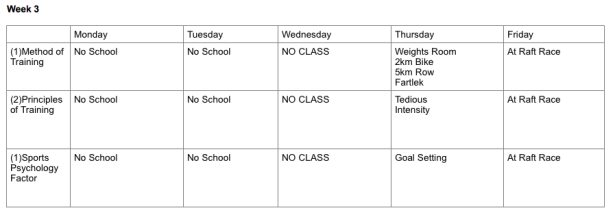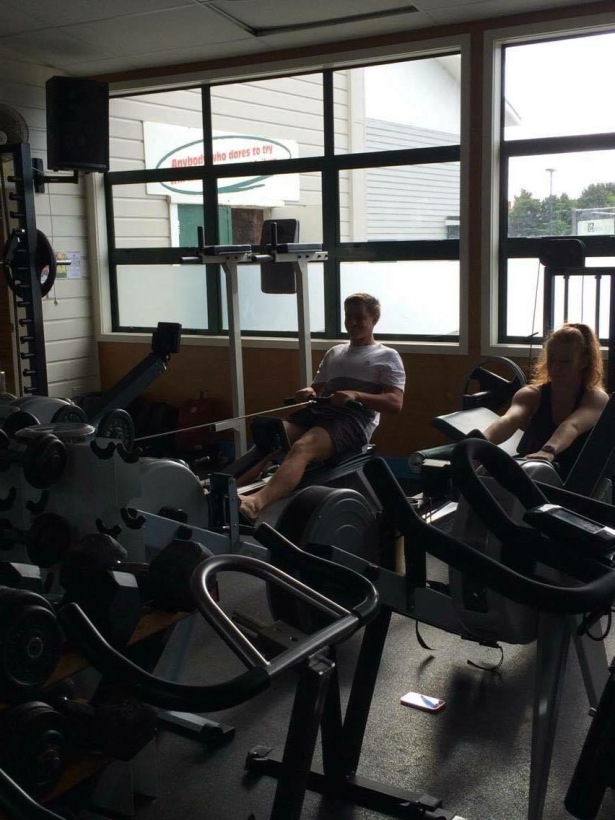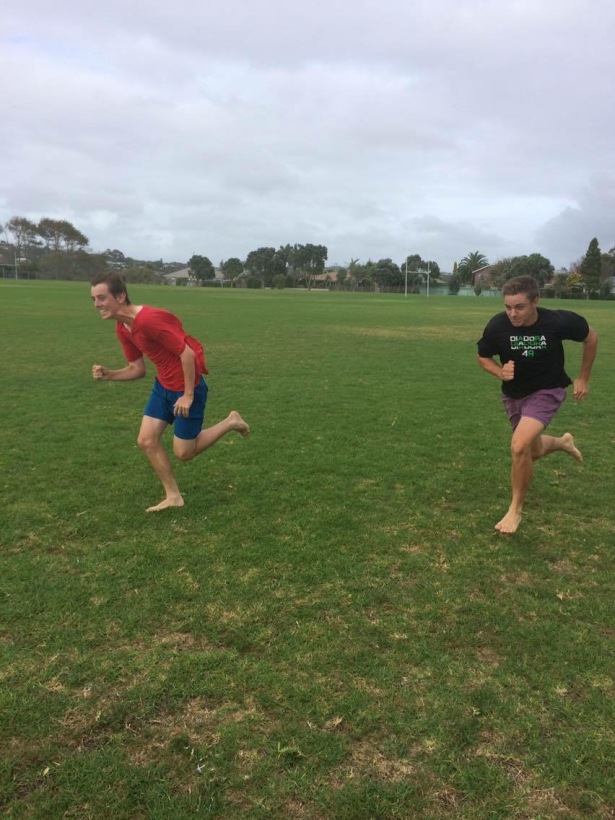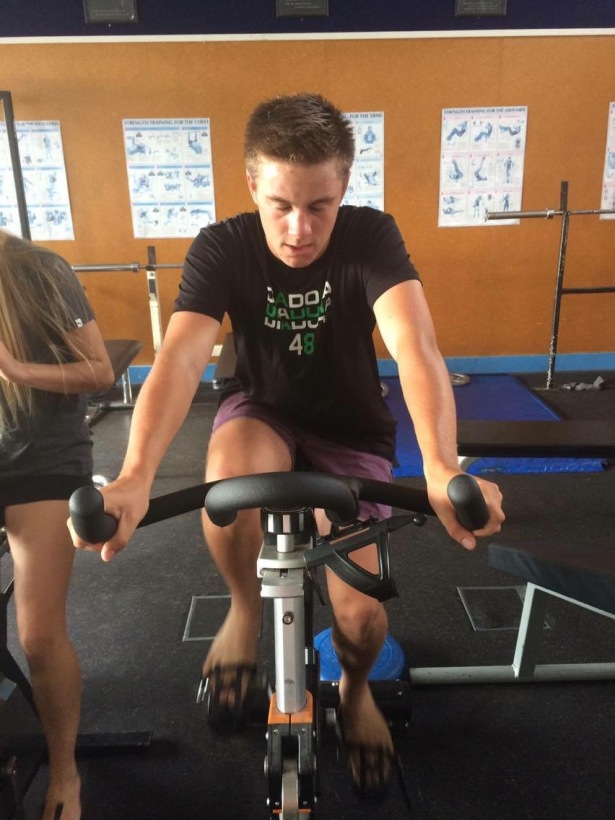
Month: April 2016
Week 3 Training Blog
Due to the short week, we only had 2 PE lessons however i was only available for 1 of them so i will be reflecting on Thursday’s lesson.
Method Of Training:
My method of training for this training session was ‘Fartlek’. Fartlek training is a mix between Interval and Continuous training as it is mainly periods of fast paced, high intensity activity with slower paced low intensity activities as the rest. This gives the body the chance to work at a much harder rate to exert more energy then continue to move during the rest so the body doesn’t cool down completely. I used Fartlek training during this training during my 2km cycle and also the 5km row. During the cycling, at points i would go at a high intensity rate for a while to get myself breathing faster then i would slow down to a lower intensity but maintain a speed that keeps my body functioning. Same applies to the rowing machine during the 5km row. This method of training allowed me to carry on with the activities at the best of my abilities by taking resting breaks but not completely stopping to regather energy.
This method of training involves both ATP-CP and aerobic as the energy systems used. Like the other methods of training, ATP-CP is used because at the start of the fartlek training, i am going at maximum effort which means i am at high intensity for a short duration of time making me not require high oxygen supply to complete the short burst. This is good because it allows me to get the quick bit of effort done quickly so then i can lower the intensity and continue the activity such as cycling at a constant speed that isn’t pushing my body to its limits. That is where the aerobic system comes into play as a good supply of oxygen is required for me to maintain the controlled low intensity speed for a long period of time during the activity before i have to use ATP-CP again when increasing the intensity of my exercise.
Throughout this whole Fartlek training session, my respiratory system was crucial in my participation for it. I constantly needed to be inhaling oxygen to ensure i could keep going during the high intensity stints and also the low intensity continuous sections also. If i was short of breath then my ability to do it the best that i could would be decreasing by a lot which would restrict me from progressing further in preparation for mountain biking as i need my respiratory system to be working perfectly to ensure i have the stamina and endurance to keep going even if my body is struggling which is why the Fartlek training makes for such a good training as it definitely helps me out. My cardiovascular system is also extremely important during the Fartlek training programme. I need the blood to be flowing efficiently through my heart and throughout my body to make sure my muscles are running smoothly so it doesn’t impact on my performance, the long rest periods that come with fartlek give my body an opportunity to catch up on my respiratory systems and also give the cardiovascular system a chance to catch up in preparation for the next high intensity sprint where my ATP-CP energy system will come into action.
My muscular system is always an important part to any physical activity. All the muscles in my legs are needed to be used to ensure that they are being worked on so that they will be match fit for when Rotorua mountain biking comes around in May. I need to build up the strength in my legs and also my endurance which is why my muscular system is so heavily involved with my training. Without it then i am not able to complete the exercises nor will i be working on anything meaning it would be a waste of time.
Principles Of Training:
My first principal of training is ‘Tedious’. Tedious relates to my fartlek training lesson as the activities i was doing in the lesson i have done multiple times. Tedious means doing the same thing over and over again until you get fed up with it. Cycling and rowing are my go to activities as i believe they are the two best ways of building up the correct muscles that are needed for mountain biking and they are both also good way of increasing endurance levels.
The effect of tedious on my training lesson is that my desire to complete each activity might of been starting to drift off as i have done in on a number of occasions. This means my drive to achieve it at the best of my ability each time is disappearing. This can be a visible effect as my times would worsen or i may not even finish. Although the two main events that i do in the lesson are ones i constantly do and they are very tedious, i still am always wanting to beat my times and perform at the best of my ability for self confidence.
My second principal is ‘Intensity’, to me this is the most important principle that can be merged with the Fartlek training system. Intensity is the rate at which the activity is completed. At a high intensity, my body is working harder and at a faster rate to keep up with my physical actions which occurs during fartlek during the short duration high intensity sections. Intensity is also seen during the low intensity constant speed parts of the training. Although my body is still working at a good rate, i am not exerting excess ATP-CP energy as i am not working at a high enough intensity so my aerobic system takes over through these parts to control my body and a lower intensity.
The effects of the intensity on fartlek training determines how hard i push myself during the activity. Increasing the intensity is forcing my body to work at the faster rate which effects my breathing rates and also blood flow to my muscles, seen through short term effects such as red face, sweating and lack of breath. The effect of a low intensity is that my body is much more capable of coping for the longer duration that this section takes as it is not overworking its self which allows the respiratory and cardiovascular system to work efficiently to catch up after the quick sprint that i would have just done.
Sports Psychology:
An extremely important sports psychology factor that is definitely seen through this method of training is goal setting. Setting goals in all activities is always good idea as it acts as an extra motivation to yourself to push your body to the limits and to achieve at the best of your ability which is what i am always aiming to do during my training lessons to make sure i get the most out of them to benefit myself in the long run leading into Rotorua mountain biking practical internal. Goal setting can be used in every single physical activity and it is a good idea to do so for your own personal confidence when you know you’ve achieved your goals.
By setting goals, it definitely helped me in my fartlek training lesson. I set myself goals on the activities so that i would have something to strive towards such as my goals for the 5km row was to finish under 25 minutes. I managed it in 22 minutes which showed to me that by setting myself a goal, i found myself pushing my body even more to make sure that i achieved it as i did not want to disappoint myself by not making my goal. This clearly indicates that it is a good motivation method and i am sure that i will continue it through to Rotorua so i can aim for my wanted grade of excellence for this practical assessment, i believe i can achieve it if i continue to work hard during my training lessons so i get the best preparation possible.


Week 2 Training Blog
Through this week we only had 2 PE lessons, i am reflecting on the Wednesday training that I did out on the back field.
Method Of Training:
The method of training that i used for this lesson was ‘Interval’. Interval training includes the need of having alternate work and rest periods. This is my favourite method of training as i am able to do a particular activity for a set length or amount of time then i have a break period of a desired length. This allows the body to refresh itself after a quick burst of energy had been used. During the lesson i used interval training as i completed a full football field shuttle then took a rest period after for 3 minutes to regather some breath. I then did a run around the field then took another break afterwards, this showed how interval training was used during my lesson as after each individual activity, i took a rest before completing the next one.
During the lesson, my ATP-CP systems were used during my quick sprint bursts that i performed, this involved ATP-CP and that is located in my muscles and it works during an exercise of short duration but high intensity which is what many parts of my training were. Another energy system that was used during the lesson was my aerobic system, this was definitely used during the long duration activities such as the full field run as i needed to have a plentiful supply of oxygen to keep me breathing and to keep my muscles fuelled so i could carry on to finish the run knowing that i would have a rest period after it which worked as an encouragement factor when i was starting to get really tired.
The respiratory system came into action during my lesson to ensure I was able to breathe during all activities. As i was doing interval training, my respiratory system has extended time during the break periods to efficiently work to get me ready to take on the next activity after knowing that my breathing was back down to normal or close to, allowing me to perform at the best of my ability for the next activity before i would receive another break. My cardiovascular or circulatory system was also extremely necessary during my training. In order to keep the blood pumping to my muscles and around my body during exercise to allow me to work at full potential. All parts of my body require nutrients and during physical activity, it requires it at a faster rate much like the blood so my cardiovascular system plays such an important role for me to be able to push my self to be the best that I can be.
From my muscular system, the main muscles that were used during this training lesson were all muscles in my legs, i have designed all my training’s to be based around gaining leg strength in the muscles such as gluteals, hamstrings, quadriceps, gastrocnemius and soleus. It is also based around my want to improve my endurance as they are the most crucial parts for mountain biking so they need to be improved if i wasn’t to be successful in Rotorua and come away with my hopeful grade of excellence. My muscles are all important to allow me to complete the activities i plan for during my training as without the use of my muscles, i wouldn’t be able to do anything so they are vital to me performing at a good level, showing that my muscular system including skeletal muscles/bones was extremely important during this training.
Principles of Training:
The first principal of training that i connected with Interval training was the ‘Time’ factor. Time refers to how long i chose to spend on either the amount of time spent on each activity or how long my entire training programme will go for. Time relates to my Interval training method as i decided that i didn’t want to spend an excessive amount of time on one activity preventing me from getting through my schedule for the lesson. However, i didn’t want to set an unrealistic time goal for all activities so they all varied. Some i wanted to complete within 5 minutes, some faster, some slower. By having a time of frame in mind, i knew how i could pace myself to ensure that i was still going hard to push myself but i didn’t want to overload it on myself as that could cause injury which would have given me a major set back leading into the mountain biking internal as i cant afford to miss lots of training.
The effect of the time factor as a principle of training meant that i pushed myself to stick within my restrictions that I set myself which also worked as a motivation to push me forward to make sure I beat the goal I set but not beat it by so much that i destroy my muscles in the process by pushing too hard.
The second principle of training is ‘Type’. Type relates to what type of activities i am doing during my training. This relates to my fitness interval training as i was selecting running activities that definitely improves my leg muscle and fitness to increase my endurance ready for mountain biking. I chose those types of activities as i know they are the most beneficial to me and i don’t see the point in doing multiple upper body strength activities as that will not help in the long run leading into the Rotorua trip, clearly showing why my type of training was important so that i got the most out of it.
The effect of the type principle was it meant that i gained the maximum results that i could from my training that will lead me in the correct direction ready for mountain biking. Specifically choosing activities that improve fitness and leg muscles will help me the most rather than mental and upper body strength as they do not have such a strong relation to mountain biking. Proving that the effect of ensuring my type of training was good to benefit me as much as possible to better myself and to prepare me for the next training lesson and also my end goal of receiving an excellence in the practical internal.
Sports Psychology:
A key sports psychology factor that i chose to relate to my interval training lesson is visualisation. I believe this is an extremely important factor that could relate to nearly any method of training. Visualisation is the idea of knowing that you could be finished a tough activity soon and that you can visualise the finish line insight which works as an extra motivator for you to keep going and push yourself to the limits. Visualisation is something that is often taught by coaches and is something that is recommended by a lot of people as it is a known fact that it does help to encourage yourself to go that extra step knowing that you will be finished soon especially when the activity is extremely tough or long.
Using visualisation definitely helped me during my training. As a sprinter, i don’t overly enjoy running anything longer than 100m, so to run around the field is a challenge for me so when i’m nearing the end, i visualise the finish line and the break that i am going to receive when i get there which lifts my spirits if i’m down in the dumps so i put in extra effort to complete the activity to the best of my ability wether its in the time frame i aim for or not, as long as i am happy with how i went. Visualisation allows me to do this and i certainly recommend it to others and it is something i use for a lot of things and it definitely helps me get through a lot.


Week 1 Training Blog
We had 4 periods of class throughout this week and i have decided to reflect on Thursdays lesson.
Method Of Training:
During Thursdays lesson, i used ‘Resistance’ as my method of training. Resistance training is any type of exercise that causes the muscles to work differently due to external resistance such as added weight. I used this method as it is best suited for the weights room and on the bikes in there as changing the resistance on the machines caters for different situations that we may face while participating in the mountain bike internal. I used resistance training by slowly increasing the resistance on the exercise bikes as i travelled further. This helped me to get the impression that at some points i may be going uphill and it also forced my legs to work at a harder rate. By changing the resistance on the rowing machines let me my legs working harder at some points then giving them breaks at others so i didn’t over kill myself during a training exercise.
The ATP-CP energy system was included during this training session during the times on the bike that i performed a quick sprint. This shows that it was the ATP-CP system used as it is an activity of short duration but high intensity so therefore i am not requiring oxygen to complete it. Another energy system that was used was the aerobic system for when i was working on the rowing machine. As i was rowing 2km, it is not an event of short duration and i definitely require oxygen to flow in if i want to complete it showing that the aerobic system was involved. This allowed me to finish the 2km at a steady pace while not running out of energy as my aerobic system was providing me with a good supply to enable me to keep going.
My respiratory system was used throughout the lesson due to doing the resistance method of training. The respiratory system is a group of organs that is reliable for the intake of oxygen to fuel our muscles and also the expelling of carbon dioxide from our body. Due to this, i was able to have enough oxygen to cater my needs while completing the training so i wasn’t short on breath which may have restricted me. My cardiovascular system (also known as circulatory system) played a crucial role to allow me to complete my training as this system involves the blood transport around my body. It also is needed for transporting oxygen, nutrients, hormones, and cellular waste products around my body to ensure that i perform at the best of my ability by not lacking any nutrients in my muscles so they are working at full potential.
An extremely important part that was involved during my resistance training was my muscular system. The muscular system is an organ system consisting of skeletal, smooth and cardiac muscles. It allows the movement of the body and circulate blood around to feed all the muscles. Without this system working, i wouldn’t of been able to complete any training as i would not be able to use the required muscles that are need to perform biking and rowing. The main muscles that were used between these exercises were my quadriceps, hamstrings, gastrocnemius and soleus muscles which are all located in my legs as these were absolutely necessary to bike and row.
Principals of Training:
The first principal of training that i linked with resistance training was ‘Progression’. I believe this relates to resistance as i progressed through the different resistance levels to better myself and to make myself put maximum effort in for the best outcomes. I was able to see progression as i improved my fitness through the increase of the resistance level which gets me closer to my personal goals of getting faster.
The effect of progressing through the resistance levels was that it meant i was working at my full potential and pushing my self to the limits at the top resistance levels to ensure that i worked up a sweat during my training to prove that i worked hard. The progression principal also now allows me to start at higher levels as my body is capable of fulfilling the requirements that comes with it.
The second principal of training that i joined with resistance training is ‘Intensity’. I believed their is a key relation between the two as when i am working at a higher resistance level, the intensity of my training increases as i will be working at a higher level to generate the output required to perform at my best while on a higher resistance level and therefore the opposite to if i was on a low resistance level where the intensity of my training will be a lot lower as i wont be working so hard to maintain the physicality of the exercise. I could clearly see the change in the intensity levels when i applied it to the biking and rowing training as i would be sweating and gasping for breath a lot more at a higher intensity with my whole body working at a faster rate to keep up where as if my intensity wasn’t so high then my body is a lot more relaxed while completing the activity.
The effect of Intensity was extremely visible by the short term effects i was facing at the higher intensity levels. More sweating, red face, lack of breath and others all played a role which clearly showed the effect of the intensity principle in my training. Another effect of the way my intensity was if my fitness is increasing by pushing myself and doing it at a faster rate at different points to push my body to its limits and it will increase my chances of going better in Rotorua on the mountain bike trip.
Sports Psychology:
One sports psychology factor that played a huge role during my training was ‘Self Talk’. I find this an extremely effective way of improving my fitness as it encourages me to push myself harder to get the best outcomes of my training. By encouraging my self while i’m completing the activity, my confidence increases and makes me believe that i can do it when my body may be struggling which shows that i have perseverance to make sure i make it to the end of the 2km in rowing for example.
This clearly shows that it helped me throughout my training and as a matter of fact in all my sporting it helps me. Im a big believer in the self talk factor and i use it a lot to encourage myself and it makes me believe in myself that i can do anything that i set my mind to, building confidence in myself. I highly recommend that people use the self talk as a psychology factor as i strongly believe it motivates you to go better, harder and faster!


